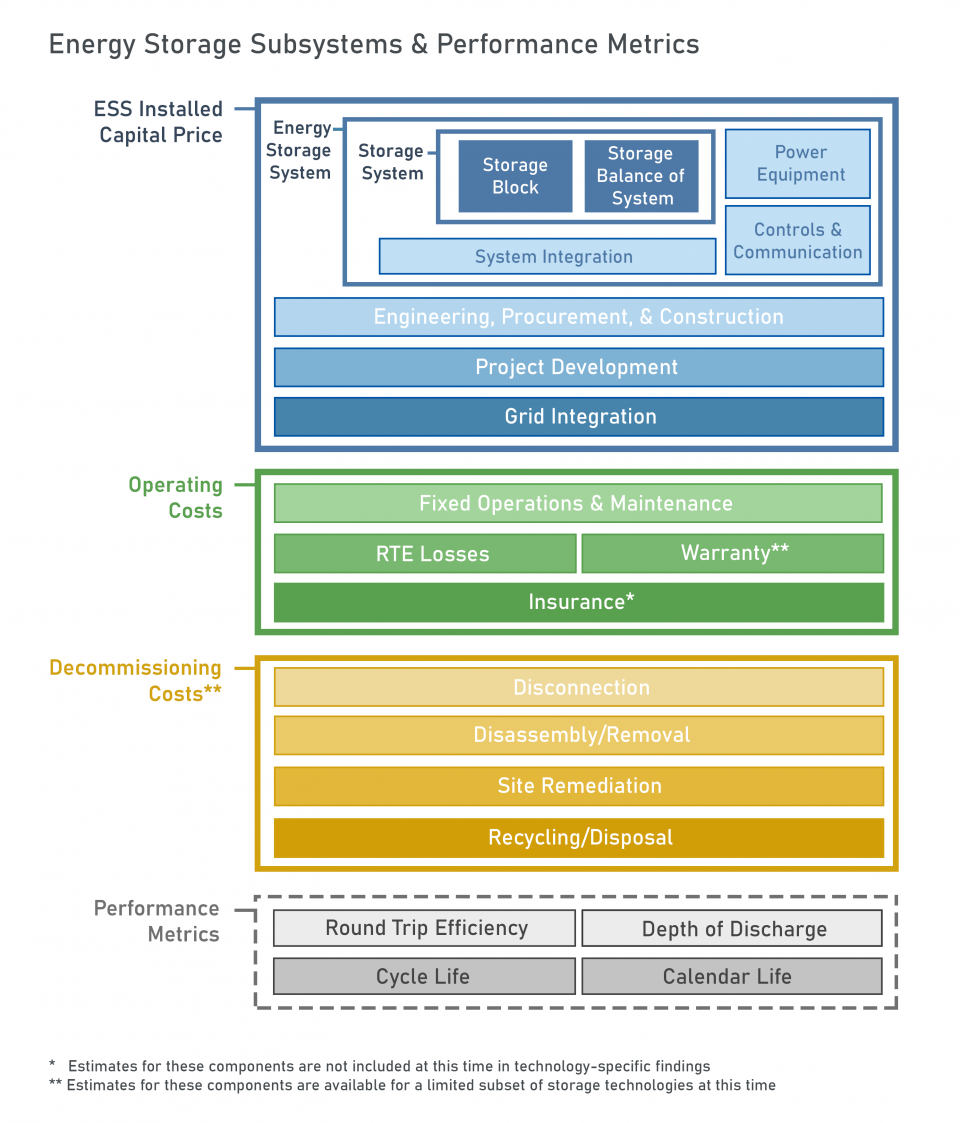Energy Storage Subsystems and Definitions

|
Component |
Definition |
|
Calendar Life |
The maximum life of the system, regardless of operating conditions. For batteries, calendar life depends on the ambient temperature and state of charge (SOC). |
|
Controls and Communication |
Includes the energy management system for the entire ESS and is responsible for ESS operation. May also include annual licensing costs for software; typically represented as a fixed cost scalable with respect to power and independent of duration. |
|
Cycle Life |
The cycle life for an ESS is a function of depth of discharge and is the total number of cycles that an ESS can provide at any depth of discharge over its life. |
|
Disconnection, Disassembly, Removal, and Site Remediation |
Costs associated with the disconnection, disassembly, removal, and site remediation. These costs may vary widely based on whether the ESS is in the built environment or outside the built environment, how far materials must be transported, and whether site remediation is necessary. |
|
Duration Corresponding to Cycle Life |
Calculated by dividing the cycle life by the number of cycles per year, accounting for downtime. |
|
Energy Storage System (ESS) |
Storage Block (SB) + Storage Balance of System (SBOS) + Power Equipment + Controls and Communication + Systems Integration |
|
Engineering Procurement and Construction (EPC) |
Includes non-recurring engineering costs, construction equipment, and shipping, siting, installation & commissioning of the ESS; cost is weighted based on duration. |
|
Fixed Operations and Maintenance (O&M) |
All costs necessary to keep the storage system operational throughout the duration of its life; costs, such as planned maintenance, parts, and labor and benefits for staff, do not fluctuate based on energy throughput. Also includes major overhaul-related maintenance, which depends on throughput. |
|
Grid Integration |
Direct cost associated with connecting the ESS to the grid, including transformer, metering, and isolation breakers. It could be a single disconnect breaker or a breaker bay for larger systems. |
|
Insurance |
Insurance fees to hold a policy to cover unknown and/or unexpected risks. Terms of this cost may depend on vendor reputation and financial strength. |
|
Power Equipment |
Bi-directional invertor, DC-DC converter, isolation protection, alternating current (AC) breakers, relays, communication interface, and software. This is the power conversion system for batteries, the powerhouse for PSH, and the power island/powertrain for CAES. |
|
Project Development |
Costs associated with permitting, power purchase agreements, interconnection agreements, site control, and financing |
|
Recycle/Disposal |
Costs associated with recycling and disposing of components less any costs recouped from sale of materials. The value of recouped materials is typically measured in cents/pound. |
|
Response Time/Ramp Rate |
Response time is the time for an ESS to go from 0 to 100% rated power, while rated power divided by response time is ramp rate. |
|
Round Trip Efficiency (RTE) |
Round-trip efficiency is simply the ratio of energy discharged to the grid from a starting state of charge to the energy received from the grid to bring the ESS to the same starting state of charge. RTE is < 1 due to the following losses - thermal management, electrochemical, power conversion, powertrain, energy conversion, evaporation, or gas/air leakage. |
|
RTE Losses |
Includes HVAC and other auxiliary loads, DC losses, power conversion system losses |
|
Site Remediation |
Costs required to return site to either Brownfield or Greenfield state |
|
Storage - Balance of System (SBOS) |
Supporting cost components for the storage block including container, cabling, switchgear, flow battery pumps, and HVAC. |
|
Storage Block (SB) |
Includes the price for the most basic DC storage element in an ESS (e.g., for lithium-ion, this price includes the battery module, rack, and battery management system, and is comparable to an electric vehicle (EV) pack price). |
|
Storage System |
The sum of the SB and SBOS costs. |
|
System Integration |
Price charged by the system integrator to integrate sub-components of a BESS into a single functional system. Tasks include procurement and shipment to the site of battery modules, racks with cables in place, containers, and power equipment. At the site, the modules and racks are containerized with HVAC and fire suppression installed and integrated with the power equipment to provide a turnkey system. |
|
Warranty |
Fees to the equipment provider for manufacturability and performance assurance over designated lifespan |